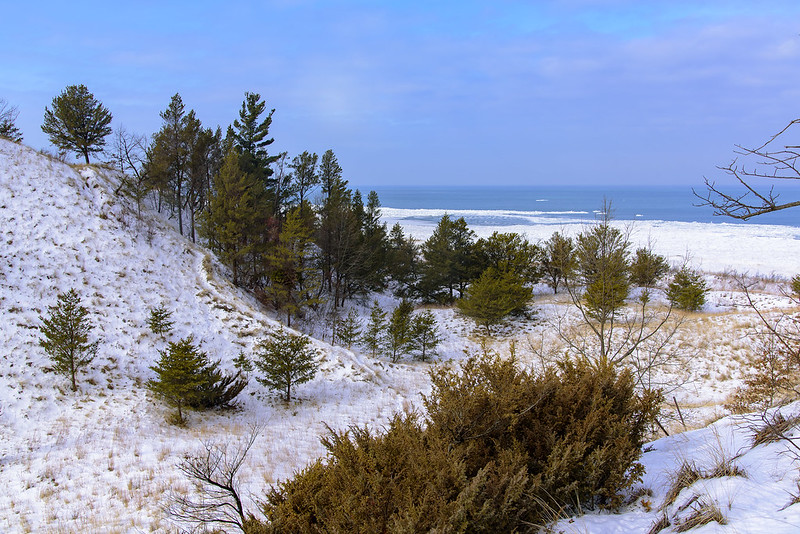
A 60 degree difference between last Wednesday and this Sunday allowed us to explore more of Starved Rock State Park's frozen waterfalls. Low temperatures of -24 F helped freeze the waterfalls solid in just a few days. Today's temperatures in the 40s began the melting process, but the cool canyons still retained most of their ice.
An unusual sight for me was the white frost on the walls of Tonti Canyon. I think it is due to the very cold temperatures a few days ago, then the warm temps yesterday and today. The warm air condensed on the cold canyon walls, and created frost. It certainly gave the canyons another layer of contrast.

In just a week's time, the main waterfall in Tonti Canyon completely froze from top to bottom. Take a look at
this post to see what the waterfall looked like last week. I'd estimate the height of the waterfall at around 60 feet, and if the cold comes back soon, this icefall will continue to build in thickness and perhaps allow ice climbers a chance at tackling the difficult climb to the top.

While being careful of the hanging icicles above, we wandered behind the icefall for a view of the backside. Unlike the thinner ice columns of LaSalle Canyon, this ice isn't as transparent, but it does offer a look at the beautiful details and patterns in the ice.
Looking closely to the left of the ice column, you can spot the second icefall of Tonti, a bit smaller, and not yet connected from top to bottom.
The Tonti Canyon bridge has been closed for quite some time, forcing visitors to take a 15 minute detour back through LaSalle Canyon. It's never a bad thing to visit this canyon twice in an afternoon, but the longer hike takes some time away from exploring other canyons along the way. I'm not sure what the State is waiting for - the bridge can be repaired for very little money, and very little time. Unless the bridge isn't the problem, perhaps it's the trail itself which seems a bit narrow just before the bridge. Either way, it's time something is done to improve a beautiful trail in Illinois' second largest attraction.
 The canyon just across the stream from Matthiessen's Cedar Point has two waterfalls, and you can usually explore behind both of them. But this time of year, so much ice has formed, it's become too thick to allow anyone inside. I generally view this waterfall from ground level, but getting up on an old trail allowed me to see the canyon above, and the path the water takes to create this 12 foot tall waterfall. There are quite a few more waterfalls in the canyon above, but they would be a bit too dangerous to explore in winter.
The canyon just across the stream from Matthiessen's Cedar Point has two waterfalls, and you can usually explore behind both of them. But this time of year, so much ice has formed, it's become too thick to allow anyone inside. I generally view this waterfall from ground level, but getting up on an old trail allowed me to see the canyon above, and the path the water takes to create this 12 foot tall waterfall. There are quite a few more waterfalls in the canyon above, but they would be a bit too dangerous to explore in winter.  From the center of the canyon, both waterfalls can be viewed at once. While a relatively small state park, Matthiessen has six waterfalls to view in a relatively short hike. Be prepared to get wet feet most of the year if you wish to see them all.
From the center of the canyon, both waterfalls can be viewed at once. While a relatively small state park, Matthiessen has six waterfalls to view in a relatively short hike. Be prepared to get wet feet most of the year if you wish to see them all.  From the head of the canyon, the first waterfall can be seen in the distance. This waterfall has a free-fall of about 16 feet, but begins quite a bit higher, with a cascade of around 20 more feet. These waterfalls don't flow too fast, but in winter, the small amount of water builds up over time, creating some interesting frozen waterfalls. Warm weather is approaching, so these falls won't be around for much longer.
From the head of the canyon, the first waterfall can be seen in the distance. This waterfall has a free-fall of about 16 feet, but begins quite a bit higher, with a cascade of around 20 more feet. These waterfalls don't flow too fast, but in winter, the small amount of water builds up over time, creating some interesting frozen waterfalls. Warm weather is approaching, so these falls won't be around for much longer.











































